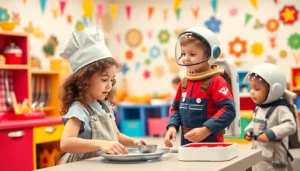Table of Contents
ToggleWatching kids tumble, flip, and soar through the air is nothing short of magical. Junior gymnastics isn’t just about perfecting a handstand or nailing a floor routine; it’s a thrilling adventure that builds strength, flexibility, and confidence. Imagine your child leaping like a superhero while learning discipline and teamwork—who wouldn’t want that?
Overview of Junior Gymnastics
Junior gymnastics offers a vibrant introduction to the world of athletic movement, focusing on developing essential skills in young athletes. This discipline cultivates physical strength and enhances flexibility through a variety of activities, including tumbling, balance beam work, and vaulting. Children build confidence as they improve their techniques and learn new routines, preparing them for more advanced challenges.
Skill acquisition in junior gymnastics occurs through structured practice and guided instruction. Experienced coaches prioritize safety and technique, ensuring that each child receives personalized attention to progress at their own pace. Participation in gymnastics also instills valuable life lessons. Teamwork becomes evident during group activities, while discipline is essential for mastering complex skills.
Moreover, junior gymnastics encourages a healthy lifestyle from a young age. Regular physical activity promotes overall well-being, reducing the risk of childhood obesity and instilling a love for fitness. As children engage in training, they experience the exhilaration of performance, whether at competitions or displays.
Junior gymnastics serves as a foundation for future athletic pursuits. Many gymnasts transition to higher levels or diversify into other sports, benefiting from their early gymnastics training. In addition, involvement in gymnastics provides opportunities for socialization, as children interact with peers who share similar interests.
Ultimately, junior gymnastics represents an enjoyable and rewarding journey that encompasses physical, mental, and social development for young athletes. It combines skill mastery with personal growth, fostering a passion for movement that can last a lifetime.
Benefits of Junior Gymnastics

Junior gymnastics offers numerous advantages that extend beyond physical prowess. This activity nurtures overall growth in children.
Physical Development
Physical development significantly enhances through junior gymnastics. Strength increases as children execute movements like tumbling and vaulting. Flexibility improves with regular stretching routines, allowing gymnasts to perform complex skills. Balance enhances when children learn beam techniques, fostering overall body control. Endurance builds during practice sessions that engage various muscle groups. These benefits contribute to healthier lifestyles and reduce obesity risks in children. Regular participation encourages motor skill development, benefiting future sports endeavors.
Mental Benefits
Mental benefits play a crucial role in junior gymnastics. Confidence boosts as children master new skills and overcome challenges. Focus sharpens during routines that require attention to detail. Discipline develops through consistent practice, teaching children the value of hard work. Teamwork flourishes when gymnasts collaborate with peers in group activities. Resilience grows as they navigate successes and setbacks in their training. This combination of skills enhances cognitive functions, preparing children for academic and social situations.
Types of Junior Gymnastics Programs
Various junior gymnastics programs cater to different skill levels and interests, ensuring children find a suitable fit. These programs typically fall into two categories: recreational and competitive.
Recreational Programs
Recreational programs focus on skill development in a fun and supportive environment. Activities include basic tumbling, balance beam exercises, and flexibility training. Coaches emphasize safety and enjoyment, allowing children to progress without pressure. Classes are often structured to encourage social interaction among peers. Skill progression occurs at each child’s unique pace, fostering a sense of achievement. For example, many gyms offer multi-level classes to accommodate varying abilities. As a result, children gain confidence, physical strength, and familiarity with gymnastics fundamentals.
Competitive Programs
Competitive programs target gymnasts seeking advancement in their sport. These programs often require a greater time commitment, with participants attending practices multiple times each week. Coaches develop personalized training plans, focusing on refining techniques and preparing athletes for competitions. Gymnasts must learn specific routines, which include floor exercises, vaults, and uneven bars. Success in these programs hinges on discipline and dedication. Athletes engage in local, regional, and even national competitions, further enhancing their skills and experience. This pathway not only nurtures talent but also fosters a deeper understanding of sportsmanship and teamwork.
Training Techniques in Junior Gymnastics
Training in junior gymnastics incorporates various techniques tailored to enhance young athletes’ skills and confidence. Coaches focus on skill progression and emphasize safety measures to create a nurturing environment.
Skill Progression
Skill progression in junior gymnastics emphasizes incremental achievements. Children learn foundational skills before advancing to more complex routines. Coaches often use drills that promote strength and flexibility alongside specific techniques for each apparatus. Practice sessions encourage repetition, allowing gymnasts to master each skill at their own pace. Structured progressions build a solid foundation, increasing both confidence and competence. For instance, young gymnasts might start with basic balance beam exercises before attempting more challenging maneuvers. Feedback from experienced coaches aids in refining techniques, ensuring the young athletes feel supported as they advance.
Safety Measures
Safety measures in junior gymnastics are paramount for protecting young athletes. Coaches prioritize the use of safety equipment, including mats and crash pads, during training sessions. Proper warm-up routines help prevent injuries, preparing the body for physical demands. Instruction on technique ensures that gymnasts perform moves correctly without risking harm. Regular assessments of gymnastic facilities guarantee safe environments for training. Coaches also emphasize physical conditioning to build strength and flexibility, further minimizing injury risks. Open communication fosters an atmosphere where athletes feel comfortable discussing concerns about safety and technique, contributing to a safer training experience.
Junior gymnastics offers children a unique blend of physical and mental development. It nurtures not just athletic skills but also essential life lessons that shape their future. As they engage in this dynamic sport, kids build strength and flexibility while cultivating confidence and resilience.
The supportive environment of junior gymnastics programs encourages teamwork and camaraderie among peers. With experienced coaches guiding their journey, children can explore their potential in a safe and structured setting.
Whether pursuing recreational or competitive paths, junior gymnastics lays the groundwork for a lifelong love of movement and fitness. It’s an enriching experience that empowers young athletes to thrive both in sports and in life.










